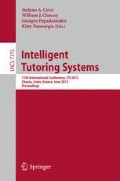Abstract
Learners experience a variety of emotions during learning sessions with Intelligent Tutoring Systems (ITS). The research community is building systems that are aware of these experiences, generally represented as a category or as a point in a low-dimensional space. State-of-the-art systems detect these affective states from multimodal data, in naturalistic scenarios. This paper provides evidence of how the choice of representation affects the quality of the detection system. We present a user-independent model for detecting learners’ affective states from video and physiological signals using both the categorical and dimensional representations. Machine learning techniques are used for selecting the best subset of features and classifying the various degrees of emotions for both representations. We provide evidence that dimensional representation, particularly using valence, produces higher accuracy.
Access this chapter
Tax calculation will be finalised at checkout
Purchases are for personal use only
Preview
Unable to display preview. Download preview PDF.
References
D’Mello, S., Craig, S., Witherspoon, A., Mcdaniel, B., Graesser, A.: Automatic detection of learner’s affect from conversational cues. User Modeling and User-Adapted Interaction 18, 45–80 (2008)
Csikszentmihalyi, M.: Flow: The psychology of optimal experience. Harper and Row, New York (1990)
Graesser, A., McDaniel, B., Chipman, P., Witherspoon, A., D’Mello, S., Gholson, B.: Detection of emotions during learning with AutoTutor. In: Proceedings of the 28th Annual Meetings of the Cognitive Science Society, pp. 285–290 (2006)
Craig, S., Graesser, A., Sullins, J., Gholson, B.: Affect and learning: an exploratory look into the role of affect in learning with AutoTutor. Learning, Media and Technology 29, 241–250 (2004)
Calvo, R.A., D’Mello, S.: New Perspectives on Affect and Learning Technologies. Explorations in the Learning Sciences, Instructional Systems and Performance Technologies, vol. 3. Springer, New York (2011)
Klein, J., Moon, Y., Picard, R.: This computer responds to user frustration: Theory, design, and results. Interacting with Computers 14, 119–140 (2002)
Hussain, M.S., AlZoubi, O., Calvo, R.A., D’Mello, S.K.: Affect Detection from Multichannel Physiology during Learning Sessions with AutoTutor. In: Biswas, G., Bull, S., Kay, J., Mitrovic, A. (eds.) AIED 2011. LNCS(LNAI), vol. 6738, pp. 131–138. Springer, Heidelberg (2011)
Graesser, A.C., Chipman, P., Haynes, B.C., Olney, A.: AutoTutor: An intelligent tutoring system with mixed-initiative dialogue. IEEE Transactions on Education 48, 612–618 (2005)
Cowie, R., Douglas-Cowie, E., Tsapatsoulis, N., Votsis, G., Kollias, S., Fellenz, W., Taylor, J.: Emotion recognition in human-computer interaction. IEEE Signal Processing Magazine 18, 32–80 (2001)
Polzin, T.: Detecting Verbal and Non-verbal cues in the communication of emotion. Unpublished Doctoral Dissertation, School of Computer Science, Carnegie Mellon University (2000)
Yacoob, Y., Davis, L.: Recognizing human facial expressions from long image sequences using optical flow. IEEE Transactions on Pattern Analysis and Machine Intelligence 18, 636–642 (1996)
Aghaei Pour, P., Hussain, M.S., AlZoubi, O., D’Mello, S., Calvo, R.A.: The Impact of System Feedback on Learners’ Affective and Physiological States. In: Aleven, V., Kay, J., Mostow, J. (eds.) ITS 2010. LNCS, vol. 6094, pp. 264–273. Springer, Heidelberg (2010)
Calvo, R.A., D’Mello, S.: Affect Detection: An Interdisciplinary Review of Models, Methods, and their Applications. IEEE Transactions on Affective Computing 1, 18–37 (2010)
Author information
Authors and Affiliations
Editor information
Editors and Affiliations
Rights and permissions
Copyright information
© 2012 Springer-Verlag Berlin Heidelberg
About this paper
Cite this paper
Hussain, M.S., Monkaresi, H., Calvo, R.A. (2012). Categorical vs. Dimensional Representations in Multimodal Affect Detection during Learning. In: Cerri, S.A., Clancey, W.J., Papadourakis, G., Panourgia, K. (eds) Intelligent Tutoring Systems. ITS 2012. Lecture Notes in Computer Science, vol 7315. Springer, Berlin, Heidelberg. https://doi.org/10.1007/978-3-642-30950-2_11
Download citation
DOI: https://doi.org/10.1007/978-3-642-30950-2_11
Publisher Name: Springer, Berlin, Heidelberg
Print ISBN: 978-3-642-30949-6
Online ISBN: 978-3-642-30950-2
eBook Packages: Computer ScienceComputer Science (R0)

